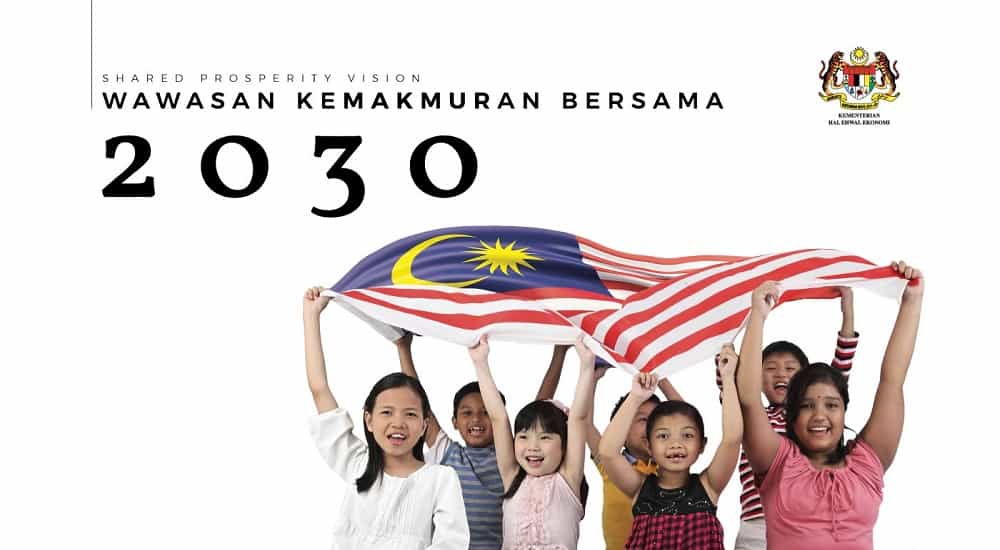What is Malaysia’s Shared Prosperity Vision 2030? Malaysia is at risk of slowing GDP growth and widening disparities. Learn how this commitment help to improve living standards of all Malaysians as outlined by Malaysia’s prime minister Tun Dr Mahathir Mohamad.

“The people who unite without prejudice in celebrating the diversity of races and cultures are fundamental to the unity of the country. The aim of the Shared Prosperity is to provide a decent standard of living to all Malaysians.” ~Tun Dr Mahathir Mohamad, Malaysia’s Prime Minister
Contents
Shared Prosperity Vision 2030
- The primary aim of Shared Prosperity Vision (SPV2030) is to provide a decent standard of living to all Malaysians by 2030.
- SPV2030 is a commitment to make Malaysia an nation that achieves sustainable growth along with fair and equitable distribution, across income groups, ethnicities, regions and supply chains. The commitment is aimed at strengthening political stability, enhancing the nation’s prosperity and ensuring that the rakyat are united whilst celebrating ethnic and cultural diversity as the foundation of the nation state.
Objectives
- Restructuring economy
- Addressing inequalities
- Nation building
Highlights
- Malaysia GDP growth is slower than China, East Asia and Pacific. Our economic growth has not realised full potential.
- Malaysians economy very reliant on commodities which face rise of price uncertainty and may result in economic downturn.
- Technology adoption is still low in manufacturing (37%) and services industries (20%), which contributes 79% of GDP.
- Income disparity between employee and capital owners is substantial which key issues being overdependence of foreign labor, and high percentages of semi- and low-skilled workers while investment in workers upskilling and automation remain low.
- Widening income disparity between T20 (Top 20%) vs B40 (Bottom 40%) groups, and between ethnicities.
- Bumiputeras are lagging behind in most registered professional occupations (besides dentistry), low contribution to GDP (if exlcuding GLCs), and low Bumiputera SME contribution to economic growth.
- Widening development disparity between urban vs rural regions.
- Corruption and abuse of power stifling economic growth and distribution.

SPV 2030 Action Plan
15 Guiding Principles
- Continuous Prosperity
- Learning Society
- Economic Centre of Asia
- Equitable Outcome
- Future Economy
- Democracy and Stability
- Equitable Growth
- Need-Based Approach Economy
- Integrity and Good Governance
- Distributed Economy
- Institutional Political-Economy
- Unity in Diversity
- Inclusivity
- Integrated Social Model
- Sovereignty and Sustainability
7 Strategic Thrusts
- Business and Industry Ecosystem
- Key Economic Growth Activities
- Human Capital
- Labour Market and Compensation of Employees
- Social Wellbeing
- Regional Inclusion
- Social Capital
8 Enablers
- Fiscal Sustainability
- Financial Capital
- Effective Institutional Delivery
- Governance & Integrity
- Education & TVET (Technical and Vocational Education and Training)
- Big Data
- Sustainability
- Enlightened Society
15 Key Economic Growth Activities (KEGA)
- Islamic Finance Hub 2.0
- Digital Economy
- Industrial Revolution 4.0
- Content Industry
- ASEAN Hub
- Halal & Food Hub
- Commodity Malaysia 2.0
- Logistic, Transportation & Sustainable Mobility
- Coastal & Maritime Economy
- Centres of Excellence
- Renewable Energy
- Green Economy
- Smart & High Value Agriculture
- Advanced & Modern Services
- Malaysia Truly Asia
Share your thoughts on Malaysia’s Shared Prosperity Vision 2030.
You May Also Like
- Wawasan Kemakmuran Bersama 2030 (Official) (mea.gov.my)
- Summary of SPV2030 (pdf) (mea.gov.my)
- Malaysia’s Tax Changes



Leave A Comment